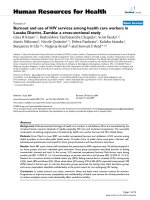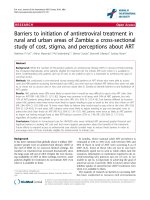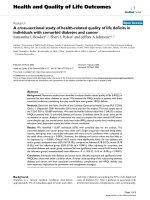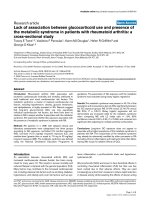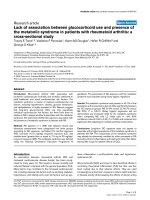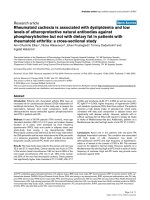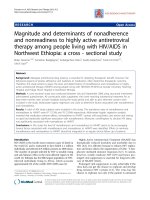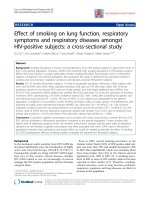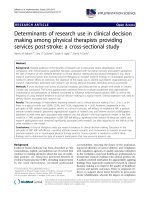A cross sectional study of pesticide use and knowledge of smallholder potato farmers in uganda
Bạn đang xem bản rút gọn của tài liệu. Xem và tải ngay bản đầy đủ của tài liệu tại đây (1.24 MB, 10 trang )
Hindawi Publishing Corporation
BioMed Research International
Volume 2015, Article ID 759049, 9 pages
/>
Research Article
A Cross-Sectional Study of Pesticide Use and Knowledge of
Smallholder Potato Farmers in Uganda
Joshua Sikhu Okonya1 and Jürgen Kroschel2
1
DCE Crop Systems Intensification and Climate Change (CSI-CC), International Potato Center (CIP),
P.O. Box 22274, Kampala, Uganda
2
DCE Crop Systems Intensification and Climate Change (CSI-CC), International Potato Center (CIP), P.O. Box 1558, Lima 12, Peru
Correspondence should be addressed to Joshua Sikhu Okonya;
Received 7 July 2015; Accepted 16 September 2015
Academic Editor: Peter P. Egeghy
Copyright © 2015 J. S. Okonya and J. Kroschel. This is an open access article distributed under the Creative Commons Attribution
License, which permits unrestricted use, distribution, and reproduction in any medium, provided the original work is properly
cited.
In response to increased pest and disease problems, potato farmers use pesticides, which could raise environmental and health
concerns. This study sought to promote proper and safe pesticide-handling practices by providing data needed to guide pesticide
regulation policy and training for extension staff and farmers. A household survey was conducted in three major potato-growing
agroecological zones of Uganda. Two hundred and four potato farmers were interviewed about the type and source of pesticides
they use in potato cultivation, the frequency of applications, the use of protective clothing, and cases of pesticide poisoning. The
types of pesticides used in potato were fungicides (72%), insecticides (62%), and herbicides (3%). Overall, use of personal protective
equipment was low, that is, gumboots (73%), gloves (7%), face masks (16%), and long sleeve shirts (42%). Forty-three percent of
farmers who applied pesticides reported having experienced skin itching, 25% skin burning sensation, 43% coughing, 60% a runny
nose, 27% teary eyes, and 42% dizziness. An IPM approach involving only moderately to slightly hazardous pesticides when pest
and disease incidence has reached economic injury levels and by considering all safety measures during application and storage
would be environmentally recommendable and result in reduced health risks.
1. Background
Potato (Solanum tuberosum L.) is an important food security
and cash crop for smallholder farmers in midelevation and
highland areas of Uganda with an annual production of 0.8
million tonnes, produced on approximately 112,000 ha [1]. It
ranks 5th among the food crops grown in Uganda after sweet
potato (Ipomoea batatas (L.) Lam.), maize (Zea mays L.),
cassava (Manihot esculenta Crantz), and banana (Musa spp.).
Most (71%) of the potato produced is for sale as ware potato in
local markets with limited formal and informal cross border
trade to neighbouring countries of Rwanda and Democratic
Republic of Congo [2].
Pests and diseases are among the most important constraints to potato production in Uganda. If not adequately
controlled, yield losses from fungal and bacterial diseases
alone can reach up to 100% [3]. Yield losses from insect pests
in Uganda have not been quantified although their severity
and damage is feared to become important with global
warming [4, 5]. The absence of environmentally friendly
approaches for management of potato pests and diseases
has left farmers with no option other than use of chemical
pesticides on a routine basis.
Farmers get exposed to toxic pesticides by eating while
spraying, entering into freshly sprayed fields, inhalation, and
direct contact of the skin with any form (liquid, powder,
or aerosol) of pesticides [6]. The Food and Agriculture
Organization (FAO) Code of Conduct for Pesticide Use is
most of the time not adhered to in many developing countries [7–10]. Misuse of pesticides can lead to illness which
reduces the availability of family farm labour and increases
the resistance of pests to pesticides due to low pesticide
rates and the frequent use of the same active ingredients
[11]. In Uganda, the impact of pesticides on human health,
environment, and farm productivity among potato farmers
has never been estimated. However, isolated cases of farm
2
workers using pesticides to commit suicide do occur. Ngowi
et al. [12] observed that it is a challenge to estimate all
costs to human health (medical expenses, recuperation costs,
transport costs, and labour losses) and the environment
(ecosystem degradation) resulting from pesticide use.
Indiscriminate use of pesticides, however, raises a number of environmental and health concerns including soil and
water pollution and human and livestock diseases among
others. For instance, high pesticide residue levels have been
reported in water bodies and foods. Evidence of pesticide
poisoning, unsafe pesticide-handling practices, and inadequate use of personal protective equipment has been reported
among farmers of horticultural crops in Uganda [13] and
coffee (Coffea arabica L.) in Jamaica [14]. In 2002, 103 cases of
pesticide poisoning leading to four deaths were registered in
Poland [15]. However, there are barely any statistics in Uganda
for cases of agricultural pesticide poisoning since most
farmers are rural and do not seek treatment from hospitals.
Even if treatment was sought, it is more likely that health
care providers are not adequately trained to make proper
diagnosis of pesticide-related illnesses as has been observed
in Ghana [9], Ivory Coast [10], Tanzania [16], and South
Africa [17]. Some programs such as the Pesticides Initiative
Programme that promotes safe pesticide use especially in
fresh export produce do exist in Uganda but no such program
is known to exist for nonexport produce like potato [18].
The lack of knowledge or training in safe pesticide-handling
practices, however, exposes both the environment and potato
farmers to the negative effects of pesticides. There is a need
to set up policies and programs to promote the safe use
of pesticides. Adherence to the international food safety
standards will increase not only market avenues of potato but
also household income. Integrated Pest Management (IPM)
strategies for potato pests ought to be promoted in Uganda to
reduce the overall use of pesticides.
This study sought to (i) identify the types of pesticides
used in potato farming systems in Uganda, (ii) document
the self-reported symptoms of pesticide poisoning, and (iii)
describe pesticide-handling practices among potato farming
households.
2. Materials and Methods
2.1. Study Area. Six subcounties (Muko, Nyarusiza, Kapchesombe, Wanale, Kibalinga, and Kakabara) in six major
potato-growing districts of Uganda (Kabale, Kisoro, Kapchorwa, Mbale, Mubende, and Kyegegwa), respectively, were
purposely selected for this study. District selection was
based on representation of the three most important potatogrowing agroecological zones of Uganda, that is, southwestern highlands (Kabale and Kisoro), eastern highlands (Mbale
and Kapchwora), and Lake Albert Crescent (Mubende and
Kyegegwa) districts. One subcounty in each district that was
observed by the agricultural extension officers to grow most
of the amount of potato was purposively selected. Verbal
informed consent was sought from the respondents prior to
the beginning of the interview. Respondents were informed
of their right to refuse participation and to withdraw from
BioMed Research International
the study at any given time. The confidentiality of the collected information was also assured.
2.2. Sampling Procedures. Farm household selection was
random and involved stopping at regular intervals (1–5 km)
along main roads traversing each subcounty. Respondents
were household heads or any adult household member who
had grown potatoes in the previous cropping season and was
present at home at the time of the study. Two hundred and
four potato farmers (34 per district and subcounty) verbally
consented to be interviewed. A structured questionnaire was
used to interview farmers. The questionnaire was written
in English and administered in English and local languages
(Luganda, Kupsabiny, Lumasaaba, Rutooro, Rukiga, and
Rufumbira) by agriculture extension officers and research
assistants under the supervision of the first author.
The interviews covered the following themes: (1) the
type and source of pesticides used in potato farming, (2)
frequency of pesticide application in a cropping season, (3)
the use of protective gear when applying pesticides, (4) any
cases of pesticide poisoning experienced by potato farmers,
and (5) individual knowledge on the negative effects of
pesticide use on the environment among others. Data for this
household baseline survey were collected between August
and September 2013.
2.3. Statistical Analysis. Raw data were coded, entered, and
analyzed using the statistical program SAS V.9.2 for Windows
(SAS, Cary, NC, USA) [19]. For each agroecological zone, a
chi-square test was used to test whether the obtained data and
their differences were significant or whether variables were
related to each other. The significance levels were set at 𝑃 ≤
0.01, 𝑃 ≤ 0.05, and 𝑃 ≤ 0.1. The results were then presented
in tables separately for each agroecological zone, from which
inferences were drawn.
3. Results and Discussion
3.1. Sociodemographic Profile. Of the 68 respondents that
were interviewed per agroecological zone, the number of
females and males was not significantly different at 𝑃 ≤ 0.1 for
all the three agroecological zones (Table 1). Respondents were
mainly between the ages of 31–64 years, followed by the youth
(18–30 years). Most of the respondents had attended school
for 1–7 years with the Lake Albert agroecological zone having
the largest proportion of farmers (72%) in this category.
3.2. Pesticide Groups Used by Potato Farmers. All farmers in
the southwestern highlands used insecticides and fungicides
on potato followed by farmers in the eastern highlands
(Table 2). Pesticides were significantly least used in the Lake
Albert Crescent with only 16% and 12% of the farmers
using fungicides and insecticides, respectively. Generally,
herbicides were used by very few farmers (3%) and no farmer
in the southwestern highlands used herbicides. The use of
both fungicides and insecticides by a large percentage of
farmers indicates that fungal diseases specifically late blight
and insect pests are perceived to be equally important.
BioMed Research International
3
Table 1: Demographic characteristics of potato farmers interviewed in August and September 2013.
Demographic variable of respondents
Sex of the respondent
Male
Female
Age group
18–30 years
31–64 years
≥65 years
Sample (mean years ± SE)∗
Education level
None (0 years)
Primary (1–7 years)
Secondary (8–11 years)
Advanced secondary (12-13 years)
University/college (≥14 years)
Sample (mean years ± SE)∗
SWH (𝑛 = 68)
Percent
Agroecological zone
EH (𝑛 = 68)
LAC (𝑛 = 68)
56
44
56
44
63
37
39.6 ± 0.9
25
66
9
41.26 ± 1.6a
29
68
3
39.28 ± 1.4a
30
66
4
38.16 ± 1.5a
6.0 ± 0.3
18
56
13
3
10
6.24 ± 0.6a
7
52
30
9
1
7.12 ± 0.5a
15
72
10
3
0
4.73 ± 0.4b
Entire sample
(mean)
𝑁 = 204
58
42
∗
Mean values with the same letter are not significantly different at 𝑃 ≤ 0.05. SWH: southwestern highlands; EH: eastern highlands; LAC: Lake Albert Crescent.
Numbers of female and male respondents were not significantly different at 𝑃 ≤ 0.1 for all the three agroecological zones.
Table 2: Percentage of potato farmers using each group of pesticides by agroecological zone in Uganda.
Percentage of farmers
using each pesticide
group
Entire sample
mean
(𝑛 = 204)
(1) Fungicides
(2) Insecticides
(3) Herbicides
72
62
3
Agroecological zone
SWH
EH
LAC
(𝑛 = 68)
(𝑛 = 68)
(𝑛 = 68)
100
100
0
99
75
1
16
12
9
SWH versus
EH
Chi2
SWH versus
LAC
EH versus
LAC
1.01ns
19.43∗∗∗
1.01ns
98.13∗∗∗
107.37∗∗∗
6.28∗∗
94.27∗∗∗
55.35∗∗∗
3.77∗
∗∗∗, ∗∗, and ∗ indicate statistical significance at 𝑃 ≤ 0.01, 𝑃 ≤ 0.05, and 𝑃 ≤ 0.1, respectively. ns: not statistically different at 𝑃 ≤ 0.1. 𝑛 = number of
respondents. SWH: southwestern highlands; EH: eastern highlands; LAC = Lake Albert Crescent.
3.3. Active Ingredients and Toxicity Classes of Pesticides Used
by Potato Farmers. The classification of pesticide active
ingredients in this study followed the WHO Recommended
Classification of Pesticides by Hazard and Guidelines to
Classification 2009 [20]. Most (54.9%) of the fungicides used
belonged to the WHO class U (unlikely to present acute hazard in normal use) while 28.9% of the insecticides belonged
to the WHO class II (moderately hazardous) (Table 3). Only
one highly hazardous (Class 1b) insecticide was used by very
few (0.5%) farmers. Due to the lack of formal seed potato
suppliers, farmers often save potatoes from the previous
own harvest for use as seed in the next cropping season.
To control the potato tuber moth Phthorimaea operculella
(Zeller) during storage, farmers used malathion in southwestern highlands. Some farmers (2.5%) did not know the
name of the fungicide they used since it was sold to them in
unlabelled polythene bags. Nearly equal number of farmers
used fungicides (75.1%) and insecticides (76.5%). However,
herbicide use was very low among potato farmers (5.4%).
Highly hazardous pesticides have been reportedly used
in many low- and middle-income countries like Peru and
Ecuador [8], Philippines [21, 22], Cambodia [23], and
Kenya [24]. In Uganda, moderately hazardous pesticides like
lambda-cyhalothrin, dimethoate, chlorpyrifos, and cypermethrin have been used in cowpea (Vigna unguiculata L. Walp.)
[25]. Jensen et al. [23] urged that farmers often think that
broad spectrum pesticides are more effective at controlling
pests and diseases and therefore the widespread use of highly
and moderately hazardous pesticides.
3.4. Frequency of Pesticide Application. The number of pesticide applications per season of three months was highest
in the eastern highlands for fungicides (5.3 ± 0.4) and
insecticides (4.2 ± 0.3) but lowest in Lake Albert Crescent
for both fungicides (2.2 ± 0.3) and insecticides (1.4 ± 0.3)
(Table 4). Some farmers applied fungicides up to 18 times and
insecticides up to 12 times per cropping season.
Frequencies of pesticide application of twice a week
have been reported in other crops like tomato (Lycopersicon
esculentum Mill.) in Uganda [13]. Other countries in Africa
reporting heavy use of pesticides include Ghana where
tomato farmers sprayed up to 12 times per season [9] and
4
BioMed Research International
Table 3: Commercial names, active ingredients, and WHO toxicity classes of pesticides used by potato farmers in Uganda.
Number Commercial pesticide name(s)
1
2
3
4
5
5
5
5
5
5
6
7
1
2
3
4
5
5
5
5
6
7
8
9
10
11
1
2
2
3
3
Active ingredient(s) and concentration
(a) Fungicides (𝑛 = 146)
Mancozeb 48% + Metalaxyl 10%
Mancozeb 56% + Metalaxyl 7.5%
Mancozeb 64% + Metalaxyl 4%
Tebuconazole 25%
Mancozeb 80%
Mancozeb 80%
Mancozeb 80%
Mancozeb 80%
Mancozeb 80%
Mancozeb 80%
Propineb 70%
Reported use (% responses)∗
WHO toxicity class(a)
9.8
2.0
5.4
0.5
II
II
II
II
U
U
U
U
U
U
U
—
Tata master 56
Agro-Laxyl MZ 63.5 WP
Ridomil Gold MZ 68 WG
Orius 25 EC
Dithane M45
Greenzeb 80 WP
Indofil M45
Agrozeb 80 WP
Greenzeb 80 WP
Mancozeb 80% WP
Antracol 70 WP
Unknown
Total responses (fungicides)
(b) Insecticide (𝑛 = 127)
Lava 100% EC
Dichlorvos 100%
Bulldock 0.25 EC
Beta-cyfluthrin 2.5%
Ambush
Permethrin 50% EC
Rocket 44 EC
Cypermethrin 4% + Profenofos 40%
Dudu Ethoate
Dimethoate 40%
Super Ethoate
Dimethoate 40%
Agrithoate 40 EC
Dimethoate 40%
Tafgor 40 EC
Dimethoate 40%
Ambush Super
Lambda-cyhalothrin
Cyclone 505 EC
Cypermethrin 10% + chlorpyrifos 35%
Dudu Alpha
Alpha-cypermethrin 3%
Dudu Cyper
Cypermethrin 5%
CyperLacer 5 EC
Cypermethrin 5%
Dursban 48 EC
Chlorpyrifos 48%
Malataf 57 EC
Malathion 57%
Total responses (insecticides)
(c) Herbicides (𝑛 = 6)
Green-2,4-D
2,4-D-Amine 860 g/L
Roundup 36% SL
Glyphosate 36%
Mamba
Glyphosate 36%
Green Fire 50% SL
Glyphosate 50%
WeedMaster 50% SL
Glyphosate 50%
Total responses (herbicides)∗
Grand Total responses (pesticides)∗ , 𝑛 = 279
54.4
0.5
2.5
75.1
0.5
0.5
30.9
14.2
Ib
II
II
II
II
II
II
II
II
II
II
II
II
II
III
7.8
0.5
0.5
1.0
4.4
0.5
15.7
76.5
0.5
II
III
III
III
III
2.5
2.5
5.5
157.1
∗
Multiple responses; 𝑛 = number of responses; (a) Ib: highly hazardous; II: moderately hazardous; III: slightly hazardous; U: unlikely to present acute hazard in
normal use.
Table 4: Number (mean ± SE) of pesticide applications per season by potato farmers in Uganda.
Number of pesticide spray regimes per
season of three months
(1) Fungicides
(2) Insecticides
(3) Herbicides
Entire sample mean ± SE (𝑛 = 204)
4.5 ± 0.2
3.8 ± 0.2
1.0 ± 0.0
Agroecological zone (mean ± SE)
SWH (𝑛 = 68)
EH (𝑛 = 68)
LAC (𝑛 = 68)
4.2 ± 0.2a
3.7 ± 0.1a
0.0 ± 0.0
5.3 ± 0.4a
4.2 ± 0.3a
1.0 ± 0.0a
2.2 ± 0.3b
1.4 ± 0.3b
1.0 ± 0.0a
Mean values with the same letter in the same row are not significantly different at 𝑃 ≤ 0.05. SWH: southwestern highlands; EH: eastern highlands; LAC: Lake
Albert Crescent.
BioMed Research International
5
Table 5: Sources of pesticides and pesticide information for potato farmers in Uganda.
Percentage of farmers who
received information about choice
of a pesticide to buy or apply
(1) Agrochemical retailers
(2) Other farmers
(3) Previous experience
(4) Agriculture extension officers
Percentage of farmers who
received information about
pesticide doses
(1) Agrochemical retailers
(2) Other farmers
(3) Previous experience/can read
(4) Agriculture extension officers
(5) Agrochemical retailers +
agriculture extension officers
Place where pesticides were
bought
(1) Agrochemical retailers
(2) General household
merchandise shops
(3) Other farmers
Entire sample (mean)
Agroecological zone
SWH
EH
LAC
𝑛 = 154
𝑛 = 68 𝑛 = 67 𝑛 = 19
34
45
19
2
𝑛 = 155
29
54
13
3
36
37
25
1
42
42
16
0
5.47ns
1.81ns
1.11ns
12.52∗∗
4.50ns
4.09ns
43.03∗∗∗
0.41ns
22.55∗∗∗
𝑛 = 68 𝑛 = 67 𝑛 = 20
33
21
45
1
26
31
38
3
34
10
55
0
50
20
30
0
1
1
0
0
𝑛 = 156
Chi2
SWH versus EH SWH versus LAC EH versus LAC
𝑛 = 68 𝑛 = 68 𝑛 = 20
60
35
90
40
40
63
10
60
1
1
0
0
∗∗∗, ∗∗, and ∗ indicate statistical significance at 𝑃 ≤ 0.01, 𝑃 ≤ 0.05, and 𝑃 ≤ 0.1, respectively. ns: not statistically different at 𝑃 ≤ 0.1. SWH: southwestern
highlands; EH: eastern highlands; LAC: Lake Albert Crescent.
Tanzania where vegetable farmers sprayed up to 16 times per
cropping season [12]. Spray frequencies observed in this study
are relatively low and may be economical [3].
An Integrated Pest Management approach that has been
specifically developed to control economically important
potato pests in Uganda involving pesticide applications only
when pest and disease incidence has reached economic injury
levels would be more sustainable and economically friendly
to the environment and hence would also reduce health risks
of farmers and consumers. Calendar spraying has also been
reported to reduce pests’ natural enemies and increase the
pest burden [26]. In a related study, we also noted that potato
farmers lack general knowledge on the existence of other
pest management strategies like the use of intercropping,
early planting, early harvesting, use of trapping devices,
sanitation, crop rotation, biopesticides, and biological control
agents in an Integrated Pest Management approach [27]. IPM
for both insect and disease management has to be region
specific. IPM for disease (bacterial wilt, viruses, and late
blight) management also involves a combination of a number
of approaches including use of resistant varieties, clean seed,
fungicides, cultural practices (planting at high altitude, crop
rotation), and farmer education [28]. In the Andean region of
Peru, for instance, IPM for insect management involving the
use of plastic barriers, attract-and-kill, and one application
of a low-toxic insecticide has been shown to be effective
in preventing Andean potato weevils (Premnotrypes spp.)
infestations, managing potato tuber moths (Phthorimaea
operculella (Zeller) and Symmetrischema tangolias (Gyen)),
and controlling flea beetles (Epitrix spp.) [29]. In the Republic
of Yemen, P. operculella was the only economically important
potato pest which could be controlled by using healthy
uninfested seed and biological control both under field and
storage conditions [30, 31]. There is therefore a need to
bring to the attention of farmers the existence of more
environmentally friendly pest management methods that can
increase profit margins.
3.5. Sources of Pesticides and Pesticide Information. Most
farmers received information about which pesticide to use
from other farmers (45%) and only 2% of the farmers
received information directly from agricultural extension
officers (Table 5). When it came to the doses of pesticides
to use, farmers in the southwestern highlands and eastern
highlands relied mostly on their own previous experience and
reading instructions on the pesticide label (38% and 55%,
resp.) while in Lake Albert Crescent, most farmers (50%)
relied on pesticide retailers.
On average, agroinput shops were the primary source of
pesticides in the three agroecological zones (60%), followed
by general household merchandise shops (40%). Other farmers (1%) represented a minor role as source of pesticides.
Pesticides were dispensed in quantities of 0.8 ± 0.1 to 8.2 ±
3.5 Kg or litres and it was common to find small quantities of
6
BioMed Research International
Table 6: Knowledge and attitudes towards pesticides among potato farmers in Uganda.
Percent pesticide use practices
(𝑛)
(1) Can read and understand the
pesticides labels
(2) Aware of the toxicity color
codes present on the pesticide
containers
(3) Aware of the negative effects
of pesticides on the environment
and health
(4) Applies pesticides on a
routine basis
(5) Has been using pesticides on
potato for >10 years
(6) Pesticides use in potato has
increased in the last 10 years
(7) Used tank mixtures of
different pesticides on potato
(8) Sex of pesticide sprayer in a
household (F: female, M: male)
SWH
EH
LAC
SWH versus
EH
Chi2
SWH versus
LAC
38 (154)
29 (68)
46 (67)
35 (20)
4.08∗∗
0.23ns
0.80ns
9 (152)
4 (68)
9 (65)
25 (20)
1.22ns
7.93∗∗∗
3.38∗
35 (154)
31 (68)
39 (67)
37 (19)
0.93ns
0.24ns
0.02ns
35 (154)
49 (68)
21 (67)
40 (20)
11.36∗∗∗
0.45ns
2.98∗
59 (155)
76 (68)
58 (67)
5 (20)
5.12∗∗
32.96∗∗∗
17.56∗∗∗
89 (107)
89 (56)
91 (45)
67 (6)
0.09ns
2.47ns
3.05∗
64 (154)
91 (68)
51 (67)
11 (19)
26.86∗∗∗
49.67∗∗∗
9.13∗∗∗
F=3
M = 90
M and F =
7 (68)
F = 10
M = 82
M and F =
7 (67)
F=5
M = 95
(19)
3.08ns
1.67ns
2.12ns
Entire sample
(mean)
𝑁 = 155
F=6
M = 87
M and F = 6
(154)
Agroecological zone
EH versus
LAC
∗∗∗, ∗∗, and ∗ indicate statistical significance at 𝑃 ≤ 0.01, 𝑃 ≤ 0.05, and 𝑃 ≤ 0.1, respectively. ns: not statistically different at 𝑃 ≤ 0.1. SWH: southwestern
highlands; EH: eastern highlands; LAC: Lake Albert Crescent. The sample size (𝑛) for each percentage is indicated in parenthesis.
fungicides in unlabelled plastic polythene bags. All farmers
used knapsack sprayers to apply pesticides.
3.6. Knowledge of Pesticide Toxicity Labels. Less than half of
the respondents could read the pesticide labelling across the
three agroecological zones; almost all respondents (91%) were
not able to explain the toxicity label (Table 6). The relatively
low level of education by the majority of the farmers (i.e., <7
years of school) may explain the inability of farmers to read
pesticide labels which are often written in English. For the few
farmers who knew how to read but did not read the pesticide
label, it could be due to reluctance or ignorance of its presence. It should be noted that there is no legislative control in
Uganda requiring sellers and users of pesticides to be formally
trained. This weakness on the part of the pesticide regulatory
bodies may explain the presence and use of highly hazardous
(Class 1b) insecticides such as dichlorvos pesticides on
the market and the reluctance to use personal protective
equipment during pesticide application reported in Table 8.
About a third of the farmers mentioned as negative
effects of pesticides symptoms of illness, reduced soil fertility,
reduction of beneficial insects, pollution of water sources, and
also crop biodiversity loss relating this specifically to the disappearance of the red-fruited nightshade (Solanum villosum
Miller) in the southwestern highlands. Nearly half (49%) of
the farmers in the southwestern agroecological zone applied
pesticides before disease symptoms or insect pests occurred.
The number of farmers who routinely applied pesticides was
lowest in the eastern highlands. There was significant chronic
exposure to pesticides among potato farmers (76% and 58%
of the farmers in the southwestern and eastern highlands,
resp.) of more than 10 years. Majority of farmers (91% in
the eastern highlands, 89% in the southwestern highlands,
and 67% in Lake Albert Crescent) perceived that the use of
pesticides in potato farming has increased in the last 10 years.
This trend in pesticide use could be due to increased disease
and pest incidence as a result of increased potato production
and climate change. It is also possible that the protection
against crop loss reaped from calendar spraying has led to
high frequencies of pesticide applications in potato [32].
Nearly two-thirds of the farmers applied pesticides in
mixtures. It was common for farmers to combine a contact
and systemic fungicide plus an insecticide within a single tank
mixture to reduce costs for pesticide applications. Reducing
costs associated with spraying was also the main reason for
combining more than one pesticide among potato farmers
in Ecuador [33] and vegetable farmers in Tanzania [12].
Although mixing pesticides can increase efficacy against
pests and diseases compared to single applications of each
pesticide, care should be taken to ensure that the pesticides
being combined are compatible with no antagonism and
cannot cause plant toxicity [34].
3.7. Farmers’ Reports of Pesticide Poisoning Symptoms. Several
farmers reported having felt sick after application of pesticides (Table 7). A runny nose was the most common reported
symptom by 54%, 72%, and 40% of the farmers in the
southwestern highlands, eastern highlands, and Lake Albert
Crescent. Skin burning and eye irritation were less common.
BioMed Research International
7
Table 7: Effects of pesticide exposure reported by farmers during and after pesticide application in Uganda.
Symptoms
Entire sample
(mean)
𝑁 = 154
(1) Itchy skin
(2) Skin burning sensation
(3) Runny nose
(4) Coughing
(5) Teary eyes/eye irritation
(6) Dizziness/headache
43
25
60
43
27
42
Agroecological zone
SWH
EH
LAC
(𝑛 = 68)
(𝑛 = 67)
(𝑛 = 20)
28
22
54
31
12
46
61
27
72
61
42
42
35
30
40
20
25
25
SWH versus
EH
Chi2
SWH versus
LAC
EH versus
LAC
15.11∗∗∗
0.42ns
4.30∗∗
12.49∗∗∗
15.56∗∗∗
0.20ns
0.37ns
0.54ns
1.28ns
0.90ns
2.15ns
2.71ns
3.56∗
0.16ns
7.78∗∗∗
12.21∗∗∗
1.84ns
2.72∗
∗∗∗, ∗∗, and ∗ indicate statistical significance at 𝑃 ≤ 0.01, 𝑃 ≤ 0.05, and 𝑃 ≤ 0.1, respectively. ns: not statistically different at 𝑃 ≤ 0.1. SWH: southwestern
highlands; EH: eastern highlands; LAC: Lake Albert Crescent.
Table 8: Use of protective clothing during pesticide application by potato farmers in Uganda (% responses).
Personal protective equipment
Entire sample
(mean)
𝑁 = 154
(1) Gloves
(2) Boots
(3) Face and nose mask
(4) Long sleeved shirt and trousers
7
73
16
42
Agroecological zone
SWH
EH
LAC
(𝑛 = 68) (𝑛 = 66) (𝑛 = 20)
3
66
10
25
12
82
19
60
5
65
20
35
SWH versus
EH
Chi2
SWH versus
LAC
EH versus
LAC
3.89∗∗
3.94∗∗
2.22ns
16.15∗∗∗
0.20ns
0.01ns
1.33ns
0.78ns
0.80ns
2.64ns
0.00ns
3.78∗
∗∗∗, ∗∗, and ∗ indicate statistical significance at 𝑃 ≤ 0.01, 𝑃 ≤ 0.05, and 𝑃 ≤ 0.1, respectively. ns: not statistically different at 𝑃 ≤ 0.1. SWH: southwestern
highlands; EH: eastern highlands; LAC: Lake Albert Crescent.
Headache, dizziness, itchy skin, cough, dry throat, blurring of vision, general body weakness, and sneezing are
some of the most common mild poisoning symptoms usually
experienced by pesticide sprayers [10, 12, 23, 35]. Contact
with pesticides has been reported to cause higher risk of cancers, neuropsychological impairments, accidental mortality,
leukaemia, and even death [15, 22, 36, 37]. Though no cases
of deaths were reported in this study, pesticide self-poisoning
accounts for about one-third of the world’s suicides [38].
During 2002 in Uganda, pesticides accounted for 46% of selfpoisoning episodes that received hospital admissions [39]. It
should be noted however that even fungicides like mancozeb
which are unlikely to cause acute hazard in normal use can
lead to long-term risk for cancer development and endocrine
disruption [40].
3.8. Use of Personal Protective Equipment as Reported by
Farmers. Use of personal protective equipment while applying pesticides was very low despite the high risk and frequency of exposure. Boots were the protective equipment
worn by majority of the farmers (66%, 83%, and 65% in the
southwestern highlands, eastern highlands, and Lake Albert
Crescent, resp.), and practically no farmer used a hat, an overall, or goggles (Table 8). Very few farmers used gloves when
handling pesticides. Handkerchiefs were often used instead of
face and nose masks which likely give a much lower level of
protection. The low investment in protective clothing during
pesticide handling could be explained by the lack of knowledge on the pesticide toxicity plus the high levels of poverty
which makes farmers unable to buy protective clothing.
Relatively very few farmers sought medical treatment
after getting signs of pesticide poisoning and the cost of
medication was relatively low (≤2$US, data not shown), not
considering overall costs which would include consultation
fees, cost of diagnosis, travel to and from the health centres,
cost of time spent in the health centre, and costs out of
productive work, among others.
Farmers often believe that pesticide-related symptoms are
normal and therefore do not seek medical treatment as was
the case in Tanzania [12], Indonesia [41], and Ivory Coast [10].
4. Conclusions, Recommendations,
and Policy Implications
This baseline study gives an insight into the range of pesticides used in the management of potato pests and diseases
in Uganda, pesticide-handling practices, and symptoms of
occupational pesticide poisoning. The protection against loss
reaped from calendar spraying has led to high frequencies of
pesticides applications in potato cultivation. Many farmers
in the study areas are not adequately informed about the
hazards associated with pesticide use and do not strictly
use protective measures to guard them and the environment
from hazards of pesticide exposure. The improper use of
highly and moderately hazardous pesticides by farmers often
resulted in pesticide poisoning among farmers. However, the
affected farmers rarely sought medical treatment. More indepth studies on the impact of pesticide exposure on the
livelihoods are recommended. Information gathered in this
study will help to guide or improve future pesticide regulation
and health interventions.
8
The lack of knowledge of pesticide use and handling
calls for investments in farmer training by governmental
extension organizations, NGOs, pesticides policy and regulatory bodies, food safety standard regulatory organization(s), and the Ministry of Agriculture. An Integrated Pest
Management approach would be the most effective way of
reducing pesticide use in potato production while protecting the environment, increasing the productivity of potato,
promoting natural enemy population build-up, and reducing
the development of pesticide resistance and human health
related risks. This baseline survey is the first step towards the
development of an IPM system conducive to Ugandan potato
farming systems.
BioMed Research International
[5]
[6]
[7]
[8]
Abbreviations
CIP:
International Potato Center
CSI-CC: Crop Systems Intensification and
Climate Change
DCE:
Disciplinary Center of Excellence
FAO:
The Food and Agriculture Organization
IPM:
Integrated Pest Management
NGO: Nongovernmental Organization
WHO: The World Health Organization.
[9]
[10]
Conflict of Interests
The authors declare that they have no competing interests.
[11]
Authors’ Contribution
[12]
Joshua Sikhu Okonya designed the study, collected and analyzed data, and drafted the paper. J¨urgen Kroschel conceived,
designed, and supervised all stages of the study. Both authors
read and approved the paper.
[13]
Acknowledgments
The authors would like to thank the extension officers in the
study subcounties for conducting the farmer interviews. The
authors are also grateful to the German Federal Ministry for
Economic Cooperation and Development (BMZ) (Grant no.
81120956) for the financial support.
References
[14]
[15]
[16]
[1] FAO, FAOSTAT, 2012, />go/to/download/Q/QC/E.
[2] P. R. Gildemacher, Innovation in seed potato systems in Eastern
Africa [Ph.D. thesis], Wageningen University, Wageningen,
Netherlands, 2012.
[3] S. Namanda, O. M. Olanya, E. Adipala et al., “Fungicide application and host-resistance for potato late blight management:
benefits assessment from on-farm studies in S.W. Uganda,” Crop
Protection, vol. 23, no. 11, pp. 1075–1083, 2004.
[4] J. Kroschel, M. Sporleder, H. E. Z. Tonnang et al., “Predicting
climate-change-caused changes in global temperature on potato
tuber moth Phthorimaea operculella (Zeller) distribution and
[17]
[18]
abundance using phenology modeling and GIS mapping,”
Agricultural and Forest Meteorology, vol. 170, pp. 228–241, 2013.
J. E. van der Waals, K. Kr¨uger, A. C. Franke, A. J. Haverkort,
and J. M. Steyn, “Climate change and potato production in
contrasting south african agro-ecosystems 3. Effects on relative
development rates of selected pathogens and pests,” Potato
Research, vol. 56, no. 1, pp. 67–84, 2013.
J. J. Okello and S. M. Swinton, “From circle of poison to circle
of virtue: pesticides, export standards and kenya’s green bean
farmers,” Journal of Agricultural Economics, vol. 61, no. 2, pp.
209–224, 2010.
FAO, International Code of Conduct on the Distribution and Use
of Pesticides, Food and Agriculture Organization of the United
Nations (FAO), Rome, Italy, 2002.
F. A. Orozco, D. C. Cole, G. Forbes, J. Kroschel, S. Wanigaratne,
and D. Arica, “Monitoring adherence to the International Code
of Conduct: highly hazardous pesticides in Central Andean
agriculture and farmers’ rights to health,” International Journal
of Occupational and Environmental Health, vol. 15, no. 3, pp.
255–268, 2009.
W. J. Ntow, H. J. Gijzen, P. Kelderman, and P. Drechsel, “Farmer
perceptions and pesticide use practices in vegetable production
in Ghana,” Pest Management Science, vol. 62, no. 4, pp. 356–365,
2006.
O. C. Ajayi, F. K. Akinnifesi, and G. Sileshi, “Human health and
occupational exposure to pesticides among smallholder farmers
in cotton zones of Cˆote d’Ivoire,” Health, vol. 03, no. 10, pp. 631–
637, 2011.
J. Gressel, “Low pesticide rates may hasten the evolution of resistance by increasing mutation frequencies,” Pest Management
Science, vol. 67, no. 3, pp. 253–257, 2011.
A. V. F. Ngowi, T. J. Mbise, A. S. M. Ijani, L. London, and O.
C. Ajayi, “Smallholder vegetable farmers in Northern Tanzania:
pesticides use practices, perceptions, cost and health effects,”
Crop Protection, vol. 26, no. 11, pp. 1617–1624, 2007.
J. Karungi, S. Kyamanywa, E. Adipala, and M. Erbaugh,
“Pesticide utilisation, regulation and future prospects in small
scale horticultural crop production systems in a developing
country,” in Pesticides in the Modern World—Pesticides Use and
Management, M. Stoytcheva, Ed., chapter 2, InTech, Rijeka,
Croatia, 2011.
D. Henry and G. Feola, “Pesticide-handling practices of smallholder coffee farmers in Eastern Jamaica,” Journal of Agriculture
and Rural Development in the Tropics and Subtropics, vol. 114, no.
1, pp. 59–67, 2013.
A. Przybylska, “Poisoning caused by chemicals for plant protection in Poland in 2002,” Przegla¸d Epidemiologiczny, vol. 58, no.
1, pp. 111–121, 2004.
A. V. F. Ngowi, D. N. Maeda, and T. J. Partanen, “Assessment
of the ability of health care providers to treat and prevent
adverse health effects of pesticides in agricultural areas of
Tanzania,” International Journal of Occupational Medicine and
Environmental Health, vol. 14, no. 4, pp. 349–356, 2001.
L. London and R. Bailie, “Notification of pesticide poisoning:
knowledge, attitudes and practices of doctors in the rural
Western Cape,” South African Family Practice, vol. 20, no. 1, pp.
117–120, 1999.
B. Schiffers, “How can rural producers in Africa become more
competitive in the face of globalisation and supply chain
integration?” in Proceedings of the 2nd European Forum on
Sustainable Development Working Group 1.4, Berlin, Germany,
June 2007.
BioMed Research International
[19] SAS Institute Inc, The SAS System for Windows v9.2, SAS
Institute Inc, Cary, NC, USA, 2008.
[20] World Health Organization, The WHO Recommended Classification of Pesticides by Hazard and Guidelines to Classification
2009, World Health Organization, Geneva, Switzerland, 2010.
[21] M. Baurdoux, D. Snelder, and G. De Snoo, “Pesticides in the
Cagayan Valley (Philippines): usage, drift patters and exposure
of farmers differing in income and market access,” Communications in Agricultural and Applied Biological Sciences, vol. 69, no.
4, pp. 765–778, 2004.
[22] J. L. Del Prado-Lu, “Pesticide exposure, risk factors and health
problems among cutflower farmers: a cross sectional study,”
Journal of Occupational Medicine and Toxicology, vol. 2, article
9, 2007.
[23] H. K. Jensen, F. Konradsen, E. Jørs, J. H. Petersen, and A.
Dalsgaard, “Pesticide use and self-reported symptoms of acute
pesticide poisoning among aquatic farmers in phnom penh,
cambodia,” Journal of Toxicology, vol. 2011, Article ID 639814,
8 pages, 2011.
[24] J. J. Okello and S. M. Swinton, “International food safety standards and the use of pesticides in fresh export vegetable production in developing countries: implications for farmer health
and the environment,” in Pesticides—Formulations, Effects, Fate,
M. Stoytcheva, Ed., InTech, Rijeka, Croatia, 2011.
[25] J. M. Erbaugh, A. R. Semana, E. Adipala, and P. Isubikalu,,
“The influence of farmer perception on pesticide usage for
management of cowpea field pests in eastern Uganda,” African
Crop Science Journal, vol. 8, no. 3, pp. 317–326, 2000.
[26] R. A. Cloyd, “Indirect effects of pesticides on natural enemies,”
in Pesticides—Advances in Chemical and Botanical Pesticides, R.
P. Soundararajan, Ed., p. 382, InTech, Rijeka, Croatia, 2012.
[27] J. Okonya and J. Kroschel, “Farmers’ knowledge and perceptions
of potato pests and their management in Uganda,” in Proceedings of the 18th International Plant Protection Congress, p. 703,
Free University Berlin, Berlin, Germany, August 2015.
[28] P. Kromann, T. Miethbauer, O. Ortiz, and G. A. Forbes, “Review
of potato biotic constraints and experiences with integrated pest
management interventions,” in Integrated Pest Management—
Experiences with Implementation, R. Peshin and D. Pimentel,
Eds., vol. 4, pp. 245–268, Springer, Dordrecht, The Netherlands,
2014.
[29] J. Kroschel, N. Mujica, J. Alcazar, V. Canedo, and O. Zegarra,
“Developing integrated pest management for potato: experiences and lessons from two distinct potato production systems
of Peru,” in Sustainable Potato Production: Global Case Studies,
Z. He, R. Larkin, and W. Honeycutt, Eds., pp. 419–450, Springer
Science+Business Media B.V, Dordrecht, The Netherlands, 2012.
[30] J. Kroschel, Integrated Pest Management in Potato Production in
the Republic of Yemen with Special Reference to the Integrated
Biological Control of the Potato Tuber Moth (Phthorimaea
operculella Zeller), vol. 8 of Tropical Agriculture, Margraf,
Weikersheim, Germany, 1995.
[31] J. Kroschel and W. Koch, “Studies on the use of chemicals,
botanicals and Bacillus thuringiensis in the management of the
potato tuber moth in potato stores,” Crop Protection, vol. 15, no.
2, pp. 197–203, 1996.
[32] B. Dinham, “Growing vegetables in developing countries for
local urban populations and export markets: problems confronting small-scale producers,” Pest Management Science, vol.
59, no. 5, pp. 575–582, 2003.
9
[33] S. Sherwood, D. Cole, C. Crissman, and M. Paredes, “From
pesticides to people: improving ecosystem health in the northern Andes,” in The Pesticide Detox: Towards a More Sustainable
Agriculture, pp. 147–164, Earthscan, 2005.
[34] R. A. Cloyd, “Pesticide mixtures,” in Pesticides—Formulations,
Effects, Fate, M. Stoytcheva, Ed., chapter 5, InTech, Rijeka,
Croatia, 2011.
[35] J. G. Thundiyil, J. Stober, N. Besbelli, and J. Pronczuk, “Acute
pesticide poisoning: a proposed classification tool,” Bulletin of
the World Health Organization, vol. 86, no. 3, pp. 205–209, 2008.
[36] L. E. Fleming, O. G´omez-Mar´ın, D. Zheng, F. Ma, and D. Lee,
“National health interview survey mortality among US farmers and pesticide applicators,” American Journal of Industrial
Medicine, vol. 43, no. 2, pp. 227–233, 2003.
[37] F. Lander and M. Ronne, “Frequency of sister chromatid
exchange and hematological effects in pesticide-exposed greenhouse sprayers,” Scandinavian Journal of Work, Environment &
Health, vol. 21, no. 4, pp. 283–288, 1995.
[38] D. Gunnell, M. Eddleston, M. R. Phillips, and F. Konradsen,
“The global distribution of fatal pesticide self-poisoning: systematic review,” BMC Public Health, vol. 7, article 357, 2007.
[39] E. Kinyanda, H. Hjelmeland, and S. Musisi, “Deliberate selfharm as seen in Kampala, Uganda—a case-control study,” Social
Psychiatry and Psychiatric Epidemiology, vol. 39, no. 4, pp. 318–
325, 2004.
[40] I. I. Novikova, A. I. Litvinenko, I. V. Boikova, V. A. Yaroshenko,
and G. V. Kalko, “Biological activity of new microbiological
preparations alirins B and S designed for plant protection
against diseases. I. Biological activity of alirins against diseases
of vegetable crops and potato,” Mikologiya i Fitopatologiya, vol.
37, no. 1, pp. 92–98, 2003.
[41] M. Kishi, N. Hirschhorn, M. Djajadisastra, L. N. Satterlee, S.
Strowman, and R. Dilts, “Relationship of pesticide spraying
to signs and symptoms in Indonesian farmers,” Scandinavian
Journal of Work, Environment and Health, vol. 21, no. 2, pp. 124–
133, 1995.
MEDIATORS
of
INFLAMMATION
The Scientific
World Journal
Hindawi Publishing Corporation
Volume 2014
Gastroenterology
Research and Practice
Hindawi Publishing Corporation
Volume 2014
Journal of
Hindawi Publishing Corporation
Diabetes Research
Volume 2014
Hindawi Publishing Corporation
Volume 2014
Hindawi Publishing Corporation
Volume 2014
International Journal of
Journal of
Endocrinology
Immunology Research
Hindawi Publishing Corporation
Disease Markers
Hindawi Publishing Corporation
Volume 2014
Volume 2014
Submit your manuscripts at
BioMed
Research International
PPAR Research
Hindawi Publishing Corporation
Hindawi Publishing Corporation
Volume 2014
Volume 2014
Journal of
Obesity
Journal of
Ophthalmology
Hindawi Publishing Corporation
Volume 2014
Evidence-Based
Complementary and
Alternative Medicine
Stem Cells
International
Hindawi Publishing Corporation
Volume 2014
Hindawi Publishing Corporation
Volume 2014
Journal of
Oncology
Hindawi Publishing Corporation
Volume 2014
Hindawi Publishing Corporation
Volume 2014
Parkinson’s
Disease
Computational and
Mathematical Methods
in Medicine
Hindawi Publishing Corporation
Volume 2014
AIDS
Behavioural
Neurology
Hindawi Publishing Corporation
Research and Treatment
Volume 2014
Hindawi Publishing Corporation
Volume 2014
Hindawi Publishing Corporation
Volume 2014
Oxidative Medicine and
Cellular Longevity
Hindawi Publishing Corporation
Volume 2014
